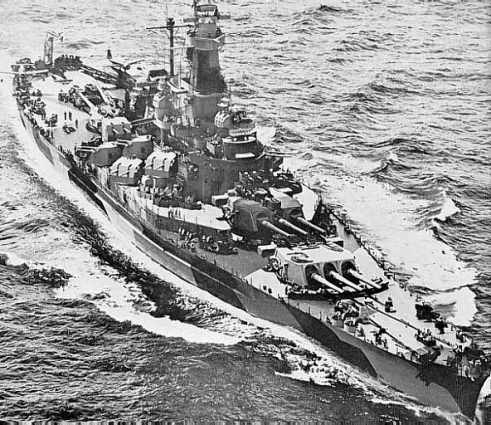

USS Indiana
Here is the personification of the American "Third Generation", with the effect of the big guns overwhelmed by more recent manifestations of the age of military technology: radar scaners and fire-control director equipment, 5-inch, 40-mm, and 20-mm high-angle artillery wherever space can be found. Taken on 28 January 1944, she is on her way to attack Taroa airfield on Maloelap in the Marshalls.
Finally came the Washingtons, South Dakotas, and Iowas, in which high speed and defense against the aerial bomb and torpedo were combined on a greater displacement with no loss of heavy firepower. The cost had risen some ten times, the displacement more than three times, the weight of broadside from 14,000 pounds to 18,000 pounds. Ten Dreadnoughts of the "First Generation", twelve of the "Second" and ten of the "Third" were completed-plus two oddities.
The South Dakotas followed as closely the pattern of the Washingtons as did the Pennsylvanias the Oklahomas. The South Dakota, the Alabama, Indiana, and Massachusetts were laid down in the second half of 1939 or early in 1940, and, in a time of ever-growing anxiety and war, were built more speedily. Still nominally of 35,000 tons displacement, like the Washingtons and the British King George V's, their tonnage was increased before completion with the addition of more high-angle guns and increased protection against aerial attack. Speed was now up to a good 30 knots, freeboard was raised to diminish optical and artillery interference in high seas, and the two funnels of the Washingtons were trunked into one squat smokestack.
American Dreadnought construction reached its zenith with the six Iowas, the first of which was laid down as Hitler was sweeping across Europe in 1940. The Kentucky and Illinois were never completed, but the Iowa, New Jersey, Missouri, and Wisconsin all saw service against Japan, although mainly after the Japanese Dreadnought fleet had ceased to count. Again the same design pattern was followed. No change in the main battery was made, the increase of 10,000 tons in displacement and 200 feet in overall length being accounted for by the additional machinery, and its protection, which made them the fastest battleships in the world. This high speed was no longer necessary for the purpose of out maneuvering the enemy and crossing the "T" in battle, but in order to keep up with the ultrafast aircraft carriers soon to join the American fleet, for whose protection they were to be chiefly responsible.
SOURCE:
Last Updated 15 January 2000

